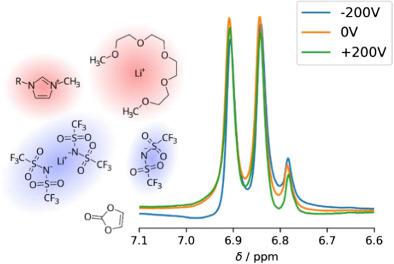当前位置:
X-MOL 学术
›
Magn. Reson. Chem.
›
论文详情
Our official English website, www.x-mol.net, welcomes your
feedback! (Note: you will need to create a separate account there.)
Spectral Deconvolution in Electrophoretic NMR to Investigate the Migration of Neutral Molecules in Electrolytes
Magnetic Resonance in Chemistry ( IF 1.9 ) Pub Date : 2020-01-08 , DOI: 10.1002/mrc.4978 Florian Schmidt 1 , Andrea Pugliese 2 , Catherine C Santini 3 , Franca Castiglione 2 , Monika Schönhoff 1
Magnetic Resonance in Chemistry ( IF 1.9 ) Pub Date : 2020-01-08 , DOI: 10.1002/mrc.4978 Florian Schmidt 1 , Andrea Pugliese 2 , Catherine C Santini 3 , Franca Castiglione 2 , Monika Schönhoff 1
Affiliation

|
Electrophoretic nuclear magnetic resonance (eNMR) is a powerful tool in studies of nonaqueous electrolytes, such as ionic liquids. It delivers electrophoretic mobilities of the ionic constituents and thus sheds light on ion correlations. In applications of liquid electrolytes, uncharged additives are often employed, detectable via 1H NMR. Characterizing their mobility and coordination to charged entities is desirable; however, it is often hampered by small intensities and 1H signals overlapping with major constituents of the electrolyte. In this work, we evaluate methods of phase analysis of overlapping resonances to yield electrophoretic mobilities even for minor constituents. We use phase‐sensitive spectral deconvolution via a set of Lorentz distributions for the investigation of the migration behavior of additives in two different ionic liquid‐based lithium salt electrolytes. For vinylene carbonate as an additive, no field‐induced drift is observed; thus, its coordination to the Li+ ion does not induce a correlated drift with Li+. On the other hand, in a solvate ionic liquid with tetraglyme (G4) as an additive, a correlated migration of tetraglyme with lithium as a complex solvate cation is directly proven by eNMR. The phase evaluation procedure of superimposed resonances thus broadens the applicability of eNMR to application‐relevant complex electrolyte mixtures containing neutral additives with superimposed resonances.
中文翻译:

电泳 NMR 中的光谱解卷积以研究电解质中中性分子的迁移
电泳核磁共振 (eNMR) 是研究非水电解质(例如离子液体)的有力工具。它提供离子成分的电泳迁移率,从而阐明离子相关性。在液体电解质的应用中,通常使用不带电的添加剂,可通过 1H NMR 检测。将它们的移动性和协调性描述为充电实体是可取的;然而,它经常受到与电解质主要成分重叠的小强度和 1H 信号的阻碍。在这项工作中,我们评估了重叠共振的相位分析方法,即使对于微量成分也能产生电泳迁移率。我们通过一组洛伦兹分布使用相敏光谱解卷积来研究添加剂在两种不同的基于离子液体的锂盐电解质中的迁移行为。对于作为添加剂的碳酸亚乙烯酯,没有观察到场致漂移;因此,它与 Li+ 离子的配位不会引起与 Li+ 相关的漂移。另一方面,在以四甘醇二甲醚 (G4) 作为添加剂的溶剂化物离子液体中,四甘醇二甲醚与作为复杂溶剂化物阳离子的锂的相关迁移由 eNMR 直接证明。因此,叠加共振的相位评估程序拓宽了 eNMR 对包含具有叠加共振的中性添加剂的应用相关复杂电解质混合物的适用性。未观察到场致漂移;因此,它与 Li+ 离子的配位不会引起与 Li+ 相关的漂移。另一方面,在以四甘醇二甲醚 (G4) 作为添加剂的溶剂化物离子液体中,四甘醇二甲醚与作为复杂溶剂化物阳离子的锂的相关迁移由 eNMR 直接证明。因此,叠加共振的相位评估程序拓宽了 eNMR 对包含具有叠加共振的中性添加剂的应用相关复杂电解质混合物的适用性。未观察到场致漂移;因此,它与 Li+ 离子的配位不会引起与 Li+ 相关的漂移。另一方面,在以四甘醇二甲醚 (G4) 作为添加剂的溶剂化物离子液体中,四甘醇二甲醚与作为复杂溶剂化物阳离子的锂的相关迁移由 eNMR 直接证明。因此,叠加共振的相位评估程序拓宽了 eNMR 对包含具有叠加共振的中性添加剂的应用相关复杂电解质混合物的适用性。
更新日期:2020-01-08
中文翻译:

电泳 NMR 中的光谱解卷积以研究电解质中中性分子的迁移
电泳核磁共振 (eNMR) 是研究非水电解质(例如离子液体)的有力工具。它提供离子成分的电泳迁移率,从而阐明离子相关性。在液体电解质的应用中,通常使用不带电的添加剂,可通过 1H NMR 检测。将它们的移动性和协调性描述为充电实体是可取的;然而,它经常受到与电解质主要成分重叠的小强度和 1H 信号的阻碍。在这项工作中,我们评估了重叠共振的相位分析方法,即使对于微量成分也能产生电泳迁移率。我们通过一组洛伦兹分布使用相敏光谱解卷积来研究添加剂在两种不同的基于离子液体的锂盐电解质中的迁移行为。对于作为添加剂的碳酸亚乙烯酯,没有观察到场致漂移;因此,它与 Li+ 离子的配位不会引起与 Li+ 相关的漂移。另一方面,在以四甘醇二甲醚 (G4) 作为添加剂的溶剂化物离子液体中,四甘醇二甲醚与作为复杂溶剂化物阳离子的锂的相关迁移由 eNMR 直接证明。因此,叠加共振的相位评估程序拓宽了 eNMR 对包含具有叠加共振的中性添加剂的应用相关复杂电解质混合物的适用性。未观察到场致漂移;因此,它与 Li+ 离子的配位不会引起与 Li+ 相关的漂移。另一方面,在以四甘醇二甲醚 (G4) 作为添加剂的溶剂化物离子液体中,四甘醇二甲醚与作为复杂溶剂化物阳离子的锂的相关迁移由 eNMR 直接证明。因此,叠加共振的相位评估程序拓宽了 eNMR 对包含具有叠加共振的中性添加剂的应用相关复杂电解质混合物的适用性。未观察到场致漂移;因此,它与 Li+ 离子的配位不会引起与 Li+ 相关的漂移。另一方面,在以四甘醇二甲醚 (G4) 作为添加剂的溶剂化物离子液体中,四甘醇二甲醚与作为复杂溶剂化物阳离子的锂的相关迁移由 eNMR 直接证明。因此,叠加共振的相位评估程序拓宽了 eNMR 对包含具有叠加共振的中性添加剂的应用相关复杂电解质混合物的适用性。











































 京公网安备 11010802027423号
京公网安备 11010802027423号